2013 Peugeot 807 belt
[x] Cancel search: beltPage 4 of 234

2
Contents
4. SAFETY 85-102
Driving safety 86
Handbrake 86
Hazard warning lights 86
Parking assistance 87
ABS and EBFD 88
Horn 88
Emergency braking
assistance 88
ASR and ESP 89
Tyre under-infl ation
detection 90
Seat belts 91
Airbags 93
Passenger air bag
disarming 93
Child seats 97
Isofi x seats 99
Recommended seats 100
Monitoring mirror 102 Steering wheel
controls 43
Lighting 43
Windscreen wipers 46
Cruise control 48
Speed limiter 51
Ventilation 54
De-icing and demisting 55
Seats 59
Front 59
Rear 64
Bench seat 69
Modularity 71
Comfort and safety 75
Layout 75
Courtesy lights 80
Sun visor 81
Mirrors and windows 82
3. EASE OF USE and
COMFORT 43-84
Presentation 4
Communication 4
Exterior 6
Interior 8
Identifi cation features 17
1. FAMILIARISATION 4-17
Accesses 18
Keys 18
Alarm 22
Doors 23
Child safety 25
Tailgate 25
Sunroofs 26
Instruments and controls 27
Control block 27
Instrument panels 28
Warning lights 29
Indicators, Display 34
Gearbox
Automatic 37
Manual 41
Steering
wheel adjustment 41
Starting and stopping 42
2. READY
TO SET OFF 18-42
Page 16 of 234
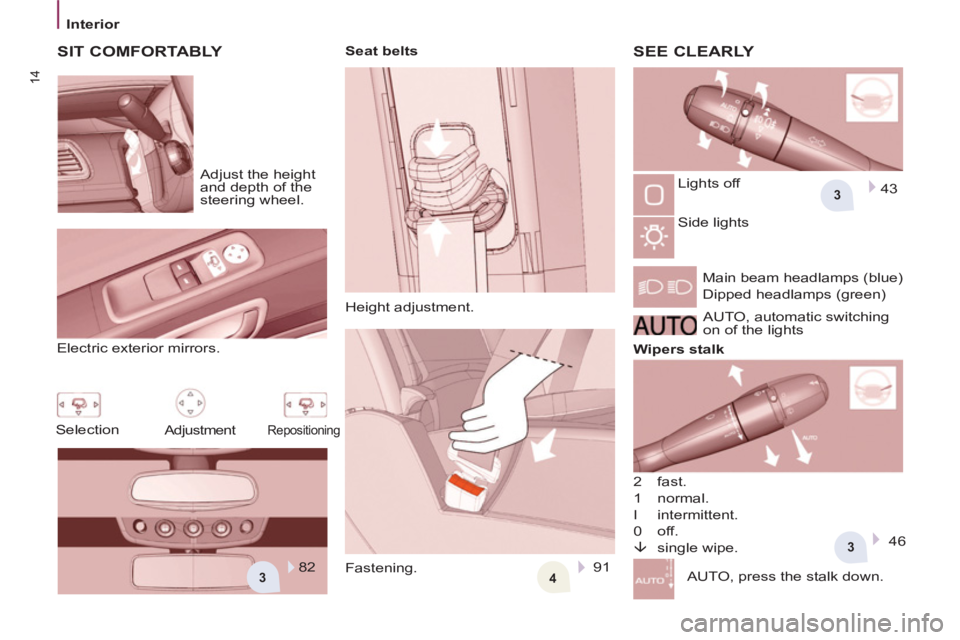
43
3
3
14
Interior
91
Repositioning
SIT COMFORTABLY
SEE CLEARLY
Adjust the height
and depth of the
steering wheel.
Electric exterior mirrors.
Selection
Seat belts
Height adjustment.
Fastening. Lights off
Side lights
Main beam headlamps (blue)
Dipped headlamps (green)
Wipers stalk
2 fast.
1 normal.
I intermittent.
0 off.
�È
single wipe.
AUTO, press the stalk down. AUTO, automatic switching
on of the lights
Adjustment
82
43
46
Page 32 of 234
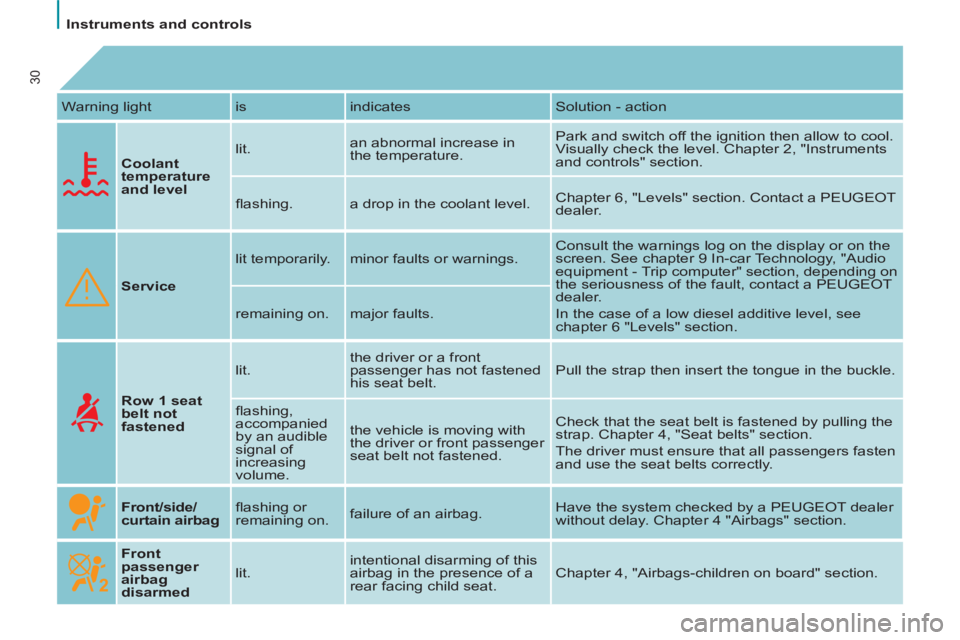
Instruments and controls
30
Warning light is indicates Solution - action
Coolant
temperature
and level
lit. an abnormal increase in
the temperature. Park and switch off the ignition then allow to cool.
Visually check the level. Chapter 2, "Instruments
and controls" section.
fl ashing. a drop in the coolant level. Chapter 6, "Levels" section. Contact a PEUGEOT
dealer.
Service
lit temporarily. minor faults or warnings. Consult the warnings log on the display or on the
screen. See chapter 9 In-car Technology, "Audio
equipment - Trip computer" section, depending on
the seriousness of the fault, contact a PEUGEOT
dealer.
In the case of a low diesel additive level, see
chapter 6 "Levels" section. remaining on. major faults.
Row 1 seat
belt not
fastened
lit. the driver or a front
passenger has not fastened
his seat belt. Pull the strap then insert the tongue in the buckle.
fl ashing,
accompanied
by an audible
signal of
increasing
volume. the vehicle is moving with
the driver or front passenger
seat belt not fastened. Check that the seat belt is fastened by pulling the
strap. Chapter 4, "Seat belts" section.
The driver must ensure that all passengers fasten
and use the seat belts correctly.
Front/side/
curtain airbag fl ashing or
remaining on. failure of an airbag. Have the system checked by a PEUGEOT dealer
without delay. Chapter 4 "Airbags" section.
Front
passenger
airbag
disarmed
lit. intentional disarming of this
airbag in the presence of a
rear facing child seat. Chapter 4, "Airbags-children on board" section.
Page 66 of 234
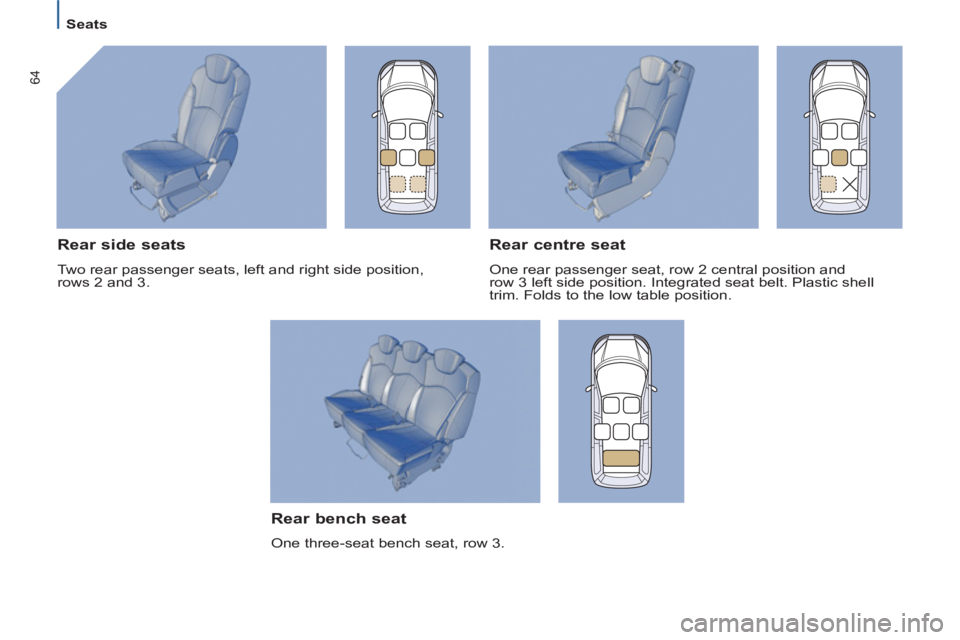
64
Seats
Rear bench seat
One three-seat bench seat, row 3.
Rear side seats
Two rear passenger seats, left and right side position,
rows 2 and 3.
Rear centre seat
One rear passenger seat, row 2 central position and
row 3 left side position. Integrated seat belt. Plastic shell
trim. Folds to the low table position.
Page 93 of 234
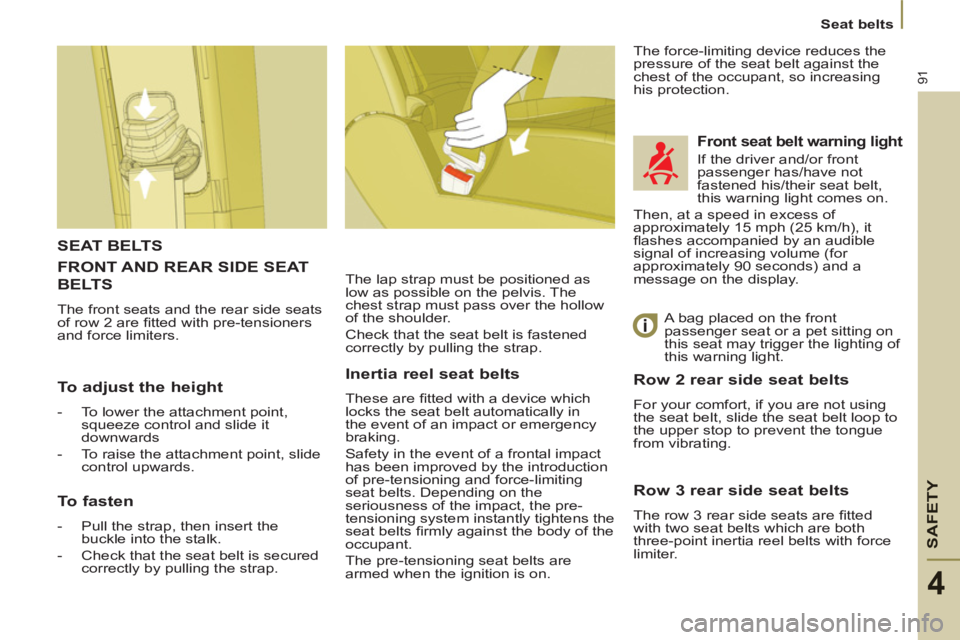
SAFETY
91
Seat belts
4
FRONT AND REAR SIDE SEAT
BELTS
The front seats and the rear side seats
of row 2 are fi tted with pre-tensioners
and force limiters. The lap strap must be positioned as
low as possible on the pelvis. The
chest strap must pass over the hollow
of the shoulder.
Check that the seat belt is fastened
correctly by pulling the strap. The force-limiting device reduces the
pressure of the seat belt against the
chest of the occupant, so increasing
his protection.
A bag placed on the front
passenger seat or a pet sitting on
this seat may trigger the lighting of
this warning light.
SEAT BELTS
Front seat belt warning light
If the driver and/or front
passenger has/have not
fastened his/their seat belt,
this warning light comes on.
Then, at a speed in excess of
approximately 15 mph (25 km/h), it
fl ashes accompanied by an audible
signal of increasing volume (for
approximately 90 seconds) and a
message on the display.
Row 2 rear side seat belts
For your comfort, if you are not using
the seat belt, slide the seat belt loop to
the upper stop to prevent the tongue
from vibrating.
To adjust the height
-
To lower the attachment point,
squeeze control and slide it
downwards
-
To raise the attachment point, slide
control upwards.
To fasten
-
Pull the strap, then insert the
buckle into the stalk.
-
Check that the seat belt is secured
correctly by pulling the strap.
Inertia reel seat belts
These are fi tted with a device which
locks the seat belt automatically in
the event of an impact or emergency
braking.
Safety in the event of a frontal impact
has been improved by the introduction
of pre-tensioning and force-limiting
seat belts. Depending on the
seriousness of the impact, the pre-
tensioning system instantly tightens the
seat belts fi rmly against the body of the
occupant.
The pre-tensioning seat belts are
armed when the ignition is on.
Row 3 rear side seat belts
The row 3 rear side seats are fi tted
with two seat belts which are both
three-point inertia reel belts with force
limiter.
Page 94 of 234
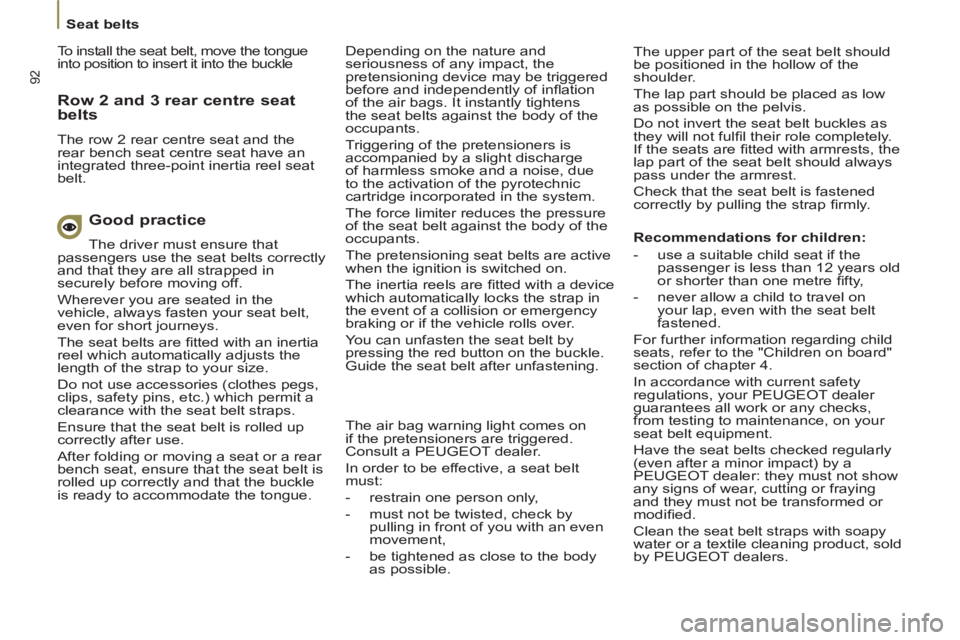
92
Seat belts
Depending on the nature and
seriousness of any impact, the
pretensioning device may be triggered
before and independently of infl ation
of the air bags. It instantly tightens
the seat belts against the body of the
occupants.
Triggering of the pretensioners is
accompanied by a slight discharge
of harmless smoke and a noise, due
to the activation of the pyrotechnic
cartridge incorporated in the system.
The force limiter reduces the pressure
of the seat belt against the body of the
occupants.
The pretensioning seat belts are active
when the ignition is switched on.
The inertia reels are fi tted with a device
which automatically locks the strap in
the event of a collision or emergency
braking or if the vehicle rolls over.
You can unfasten the seat belt by
pressing the red button on the buckle.
Guide the seat belt after unfastening. The upper part of the seat belt should
be positioned in the hollow of the
shoulder.
The lap part should be placed as low
as possible on the pelvis.
Do not invert the seat belt buckles as
they will not fulfi l their role completely.
If the seats are fi tted with armrests, the
lap part of the seat belt should always
pass under the armrest.
Check that the seat belt is fastened
correctly by pulling the strap fi rmly.
Good practice
The driver must ensure that
passengers use the seat belts correctly
and that they are all strapped in
securely before moving off.
Wherever you are seated in the
vehicle, always fasten your seat belt,
even for short journeys.
The seat belts are fi tted with an inertia
reel which automatically adjusts the
length of the strap to your size.
Do not use accessories (clothes pegs,
clips, safety pins, etc.) which permit a
clearance with the seat belt straps.
Ensure that the seat belt is rolled up
correctly after use.
After folding or moving a seat or a rear
bench seat, ensure that the seat belt is
rolled up correctly and that the buckle
is ready to accommodate the tongue. To install the seat belt, move the tongue
into position to insert it into the buckle
Row 2 and 3 rear centre seat
belts
The row 2 rear centre seat and the
rear bench seat centre seat have an
integrated three-point inertia reel seat
belt.
The air bag warning light comes on
if the pretensioners are triggered.
Consult a PEUGEOT dealer.
In order to be effective, a seat belt
must:
- restrain one person only,
- must not be twisted, check by
pulling in front of you with an even
movement,
- be tightened as close to the body
as possible.
Recommendations for children:
- use a suitable child seat if the
passenger is less than 12 years old
or shorter than one metre fi fty,
- never allow a child to travel on
your lap, even with the seat belt
fastened.
For further information regarding child
seats, refer to the "Children on board"
section of chapter 4.
In accordance with current safety
regulations, your PEUGEOT dealer
guarantees all work or any checks,
from testing to maintenance, on your
seat belt equipment.
Have the seat belts checked regularly
(even after a minor impact) by a
PEUGEOT dealer: they must not show
any signs of wear, cutting or fraying
and they must not be transformed or
modifi ed.
Clean the seat belt straps with soapy
water or a textile cleaning product, sold
by PEUGEOT dealers.
Page 95 of 234
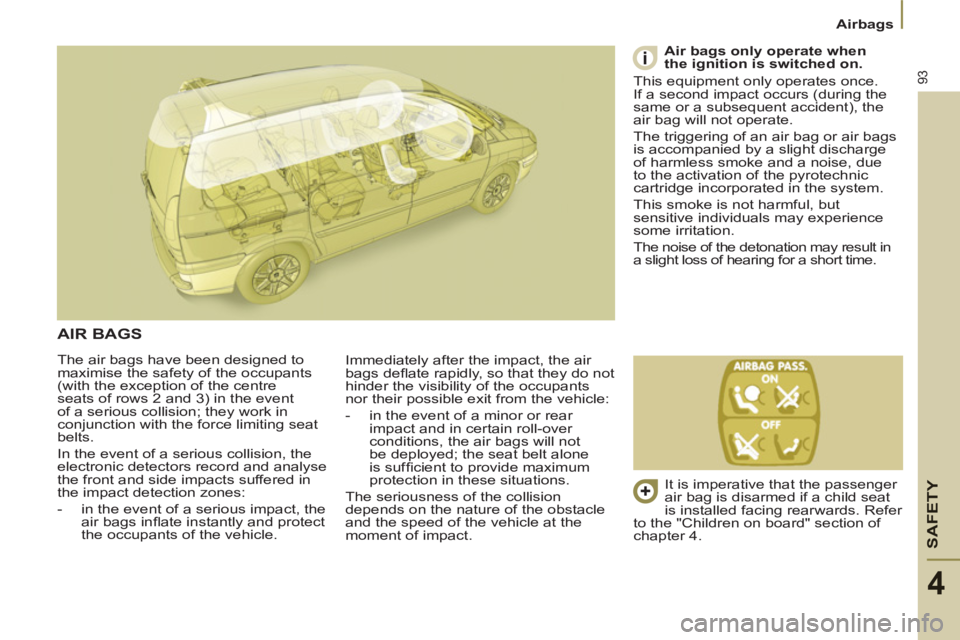
SAFETY
93
Airbags
4
The air bags have been designed to
maximise the safety of the occupants
(with the exception of the centre
seats of rows 2 and 3) in the event
of a serious collision; they work in
conjunction with the force limiting seat
belts.
In the event of a serious collision, the
electronic detectors record and analyse
the front and side impacts suffered in
the impact detection zones:
- in the event of a serious impact, the
air bags infl ate instantly and protect
the occupants of the vehicle. Immediately after the impact, the air
bags defl ate rapidly, so that they do not
hinder the visibility of the occupants
nor their possible exit from the vehicle:
- in the event of a minor or rear
impact and in certain roll-over
conditions, the air bags will not
be deployed; the seat belt alone
is suffi cient to provide maximum
protection in these situations.
The seriousness of the collision
depends on the nature of the obstacle
and the speed of the vehicle at the
moment of impact.
Air bags only operate when
the ignition is switched on.
This equipment only operates once.
If a second impact occurs (during the
same or a subsequent accident), the
air bag will not operate.
The triggering of an air bag or air bags
is accompanied by a slight discharge
of harmless smoke and a noise, due
to the activation of the pyrotechnic
cartridge incorporated in the system.
This smoke is not harmful, but
sensitive individuals may experience
some irritation.
The noise of the detonation may result in
a slight loss of hearing for a short time.
AIR BAGS
It is imperative that the passenger
air bag is disarmed if a child seat
is installed facing rearwards. Refer
to the "Children on board" section of
chapter 4.
Page 96 of 234
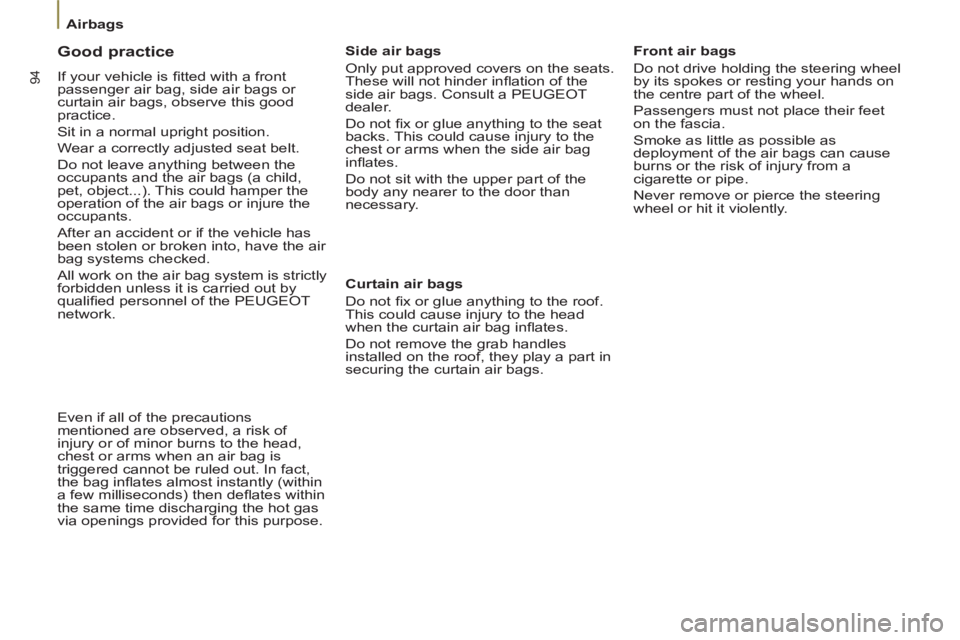
94
Airbags
Good practice
If your vehicle is fi tted with a front
passenger air bag, side air bags or
curtain air bags, observe this good
practice.
Sit in a normal upright position.
Wear a correctly adjusted seat belt.
Do not leave anything between the
occupants and the air bags (a child,
pet, object...). This could hamper the
operation of the air bags or injure the
occupants.
After an accident or if the vehicle has
been stolen or broken into, have the air
bag systems checked.
All work on the air bag system is strictly
forbidden unless it is carried out by
qualifi ed personnel of the PEUGEOT
network.
Front air bags
Do not drive holding the steering wheel
by its spokes or resting your hands on
the centre part of the wheel.
Passengers must not place their feet
on the fascia.
Smoke as little as possible as
deployment of the air bags can cause
burns or the risk of injury from a
cigarette or pipe.
Never remove or pierce the steering
wheel or hit it violently.
Side air bags
Only put approved covers on the seats.
These will not hinder infl ation of the
side air bags. Consult a PEUGEOT
dealer.
Do not fi x or glue anything to the seat
backs. This could cause injury to the
chest or arms when the side air bag
infl ates.
Do not sit with the upper part of the
body any nearer to the door than
necessary.
Curtain air bags
Do not fi x or glue anything to the roof.
This could cause injury to the head
when the curtain air bag infl ates.
Do not remove the grab handles
installed on the roof, they play a part in
securing the curtain air bags.
Even if all of the precautions
mentioned are observed, a risk of
injury or of minor burns to the head,
chest or arms when an air bag is
triggered cannot be ruled out. In fact,
the bag infl ates almost instantly (within
a few milliseconds) then defl ates within
the same time discharging the hot gas
via openings provided for this purpose.